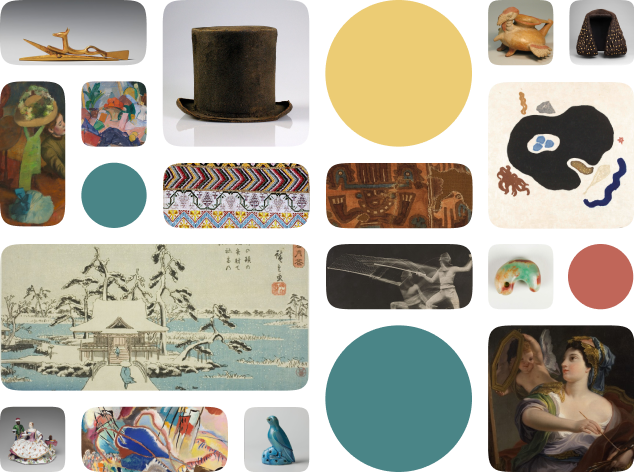Mummy and Portrait of Demetrios
Creator Name
Cultural Context
Date
Source
About the work
This portrait of an elite Greco-Egyptian man is affixed to a mummy, likely the sitter. Writings on the mummy wrappings indicate he is Demetrios, who died at 59 years old.
Ancient Egyptians believed that the soul lived after death if the body was preserved. Mummification was thus fundamental to the Egyptian afterlife starting in at least 2500 BCE. After curing and wrapping the body in linen, priests affixed a mask, typically made of cartonnage. During the Roman Imperial period, elite Greco-Egyptians used individualized wood-panel portraits as masks.
Demetrios’ shroud includes Egyptian symbols of divinity applied with expensive lead paint imported to Egypt from Spain. He wears a gilded laurel wreath. The expensive materials and inclusion of his biographical details indicate Demetrios was a man of importance who wished to have his status, as well as his soul, preserved for eternity. Read more about displays of status in Fayum portraits.
Ancient Egyptians believed that the soul lived after death if the body was preserved. Mummification was thus fundamental to the Egyptian afterlife starting in at least 2500 BCE. After curing and wrapping the body in linen, priests affixed a mask, typically made of cartonnage. During the Roman Imperial period, elite Greco-Egyptians used individualized wood-panel portraits as masks.
Demetrios’ shroud includes Egyptian symbols of divinity applied with expensive lead paint imported to Egypt from Spain. He wears a gilded laurel wreath. The expensive materials and inclusion of his biographical details indicate Demetrios was a man of importance who wished to have his status, as well as his soul, preserved for eternity. Read more about displays of status in Fayum portraits.
Brooklyn Museum Object Description
Mummy of Demetrios enveloped in red painted cloth elaborately decorated with gilt figures.
When the Romans ruled Egypt (30 B.C.E.–642 C.E.), some wealthy Greeks there were mummified. This mummy was made with expensive imported materials that show the wealth Demetrios commanded in life. It is wrapped in a linen shroud painted with red pigment made with lead imported from Spain. The mummy includes a Roman-style portrait of Demetrios painted on a wooden panel in the medium of encaustic, or wax plus pigment. (Compare it to the less costly portrait painted directly on Neferhotep’s shroud, nearby.) Artists added Egyptian divine symbols to the mummy shroud and the deceased’s name and age at death, recorded ...
When the Romans ruled Egypt (30 B.C.E.–642 C.E.), some wealthy Greeks there were mummified. This mummy was made with expensive imported materials that show the wealth Demetrios commanded in life. It is wrapped in a linen shroud painted with red pigment made with lead imported from Spain. The mummy includes a Roman-style portrait of Demetrios painted on a wooden panel in the medium of encaustic, or wax plus pigment. (Compare it to the less costly portrait painted directly on Neferhotep’s shroud, nearby.) Artists added Egyptian divine symbols to the mummy shroud and the deceased’s name and age at death, recorded ...
Work details
"--" = no data available
Title
Creator
Worktype
Cultural Context
Material
Dimensions
Technique
--
Language
Date
Provenance
Style Period
--
Rights
Inscription
Location
Source
Subjects
Topic
Curationist Metadata Contributors
All Works in Curationist’s archives can be reproduced and used freely. How to attribute this Work:
Unknown, Mummy and Portrait of Demetrios, 95–100. Metropolitan Museum of Art. A portrait of a Greco-Egyptian man affixed to a mummy. Writings on the mummy wrappings indicate he is Demetrios, who died at 59 years old. Creative Commons Attribution.
Help us improve this content!
Let our archivists know if you have something to add.
Save this work.
Start an account to add this work to your personal curated collection.
